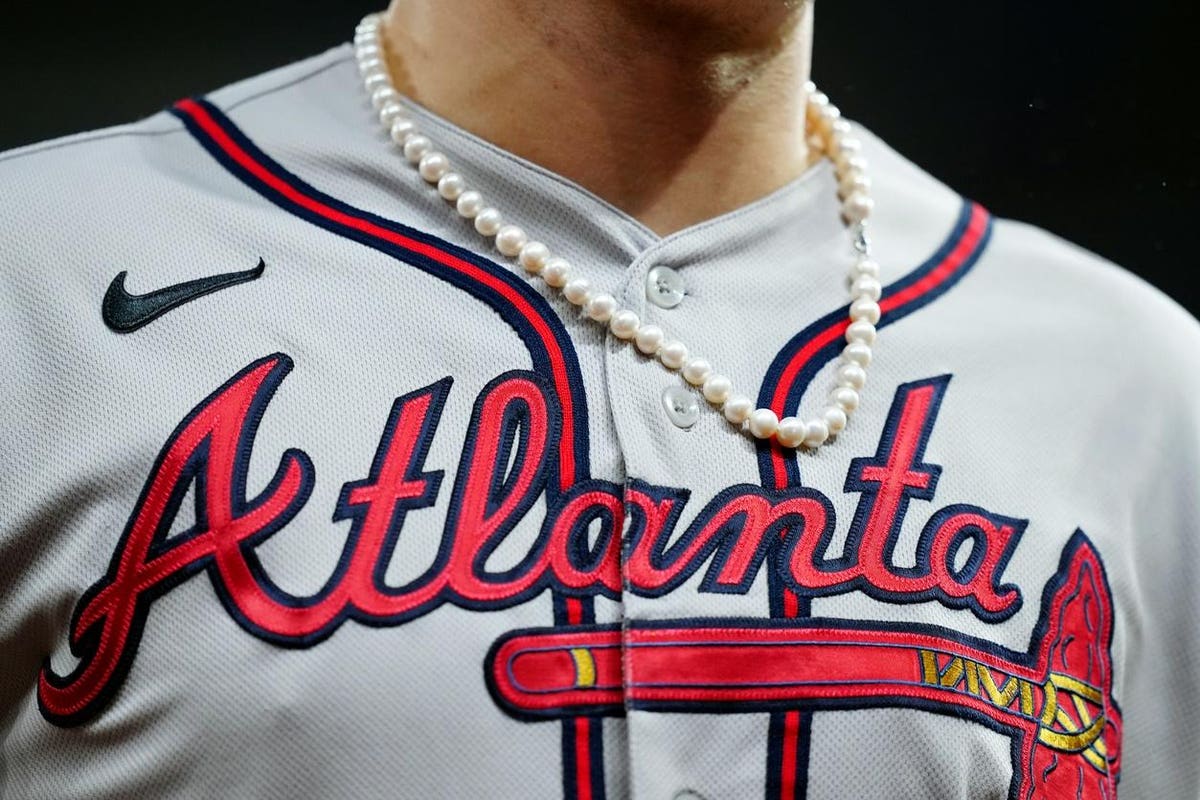Pearls for men are having a fashion moment, but many wonder if it is a trend that has staying power. Mikimoto, a name synonymous with pearls, is counting on the men in pearls trend to last.
It’s not so surprising when the glitterati adopts this most lady-like of gems. Harry Styles, A$AP Rocky, Pharrell Williams, Billy Porter, Shawn Mendes, Sir Elton John, Jordan Firstman, the Jonas Brothers, Timothée Chalamet, and Tyler, the Creator, are among the famous faces who have metaphorically raided their mother’s jewelry box for a strand.
But when athletes sport them, it’s a sign that pearls are breaking their female-centric boundaries into the gender-fluid mainstream. Soccer stars Raheem Sterling and James Maddison have adopted the style and wide-reciever Garrett Wilson was all the talk at the 2022 NFL draft when he showed up in a three-tiered pearl necklace to be picked up by the New York Jets.
But all-star outfielder and power-hitter Joc Pederson became the breakout sports star in pearls when he wore them to clinch the Atlanta Braves’ 2021 World Series title. His strand has since been retired to the Cooperstown Baseball Hall of Fame.
“Pearls for men have been everywhere lately,” wrote Highsnobiety culture editor Lia McGarrigle. “Men wearing pearls isn’t a fad; it’s an example of how the jewelry world is finally opening up to genderless style.”
“While pearls are currently reserved for the most fashion-forward among us, in a few years, pearl necklaces are about to be as commonplace as chains are for men,” she added.
Mikimoto’s Power Play
Mikimoto has been on the leading edge of pearls for men for years. Now celebrating its 130th anniversary, it is launching a new “Love Pearls” campaign featuring seven brand devotees, dominated by men, to show how modern men can wear pearls. However, it doesn’t overlook modern women too.
Love Pearls compliments its “Love Letter to the Sea” anniversary campaign that draws attention to why pearls are a life-sustaining choice in jewelry. As a natural, sustainable and renewable gemstone from the sea, their culture benefits, rather than harms, the environment.
Men featured in the Love Pearls campaign include designer Marc Jacobs, who calls his ever-present strand of white Mikimoto pearls his good luck charm. Also featured are actors Song Wei Long, James Jirayu and Taishi Nakagawa.
They are joined by actors Dilraba, Mari Natusuki and Ai Tominaga capturing the female love of pearls.
“Pearls are very popular to both men and women, particularly in Asia, which is reflected in those participating in our campaign,” said Yugo Tsukikawa, the company’s director of marketing and product strategy Americas.
“Growth there has been tremendous, but also good in the United States and Europe where male celebrities are picking up pearls,” he said and added, “If you walk around Tokyo, you’ll see men wearing strands of pearls every day.”
Evolving Social Constructs
“Pearls in and of themselves are neither masculine nor feminine. Their feminization is a social construct,” said consumer psychologist Chris Gray, The Buycologist. And the originating social construct of pearls was that they were the gemstone of kings, emperors and maharajas because of their extreme rarity.
Pearls were the ultimate power status symbol of such macho men as Henry VIII and Sir Walter Raleigh. Julius Caesar allowed only those of the Roman ruling class to wear pearls and Babur, founder of India’s 16th-century Mughal empire and descendent of Ghengis Kahn, wore long strands of them and passed the tradition along to his male descendents.
After Mikimoto founder Kokichi Mikimoto invented cultured pearl technology, it made pearls accessible to the masses. Mikimoto’s goal was “to adorn the necks of all women around the world with pearls.” Now, men are rediscovering the power of pearls to make a statement of their status, just like they use ties, cuff links and watches.
“If we look back in time, what has been considered traditionally masculine has shifted dramatically. Our founding fathers wore wigs and tights,” Gray quips.”These social constructs, especially with masculinity and feminity, are always shifting.”
He observes that with the feminist movement and entry of women in the workforce, men are feeling some “encroachment in their territory” and looking for options that aren’t “boxed in by traditional masculinity.”
It’s the very definition of fluidity that rejects the rigid norms and perceptions of what’s masculine and feminine.
“We put these constraints on neutral objects, giving them meaning that isn’t inherent. What makes a gold chain masculine versus a string of pearls? It’s a social construct that is bound to change,” he continued and observed that a man wearing pearls today makes a loud statement about his self-confidence and security in his masculinity.
Black And White
The pearl social construct is evolving more rapidly in Asian cultures, but the West is catching up.
Black pearls showcased in Mikimoto Passionnoir collection have resonated strongly with men, as has its collaboration with Commes des Garçons featuring more traditionally masculine symbols of sterling silver fangs and safety pins.
But now, the company doesn’t assign genders to its jewelry pieces. And given the quiet luxury beauty of regular pearls, the social construct that limits black pearls to men is fading.
“Things like diamonds and gold are really flashy and shiny. Pearls have instant elegance and allure,” Tsukikawa said. “Men who wear pearls are very confident and fashionable. And if he’s already wearing a black strand, why not a white?”
Pearlcore Trend
Global pearl jewelry is estimated to have reached $10.5 billion in 2022, but is slated to grow at a 13% compound-annual-growth rate through 2030 to top $25 billion, according to Zion Market Research.
While it’s small relative to the $90 billion diamond jewelry market, pearl jewelry’s popularity is growing among younger consumers, where pearls’ natural sustainability has special appeal and with whom traditional gender norms are crumbling.
“More work needs to be done to show how pearls have come a long way from the small, white pearl strands grandma used to wear to a world of shapes, sizes, colors and prices to satisfy every taste and budget,” concluded a study on the pearl jewelry market by MVEye and the Cultured Pearl Association.
MVEye founder Marty Hurwitz challenges jewelry retailers to catch up to the growing interest in pearls among consumers, both men and women. Retailers that lean into the “Pearlcore” trend signal their modernity and can expand their target market with unisex appeal.
Zales, part of the Signet family of brands, is one mass-market retailer answering the call. “Pearls are probably one of the first jewelry categories that we see men cross over into,” Angie Kennedy, Zales’ vice president of merchandising, told CNN Business.
“At Signet, we’re looking at every category and thinking, OK, do we have the offering for both him and her? Every idea we come across, we’re now thinking about how can we make it more gender fluid,” she concluded.
See Also:
Read the full article here





